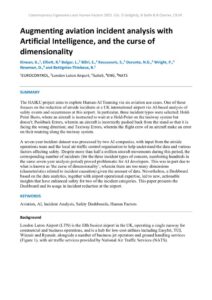| Document | Author Kirwan, B.,1, Elliott, R.2 Bolger, L.,2 Biliri, E.,3 Koussouris, S.,3 Durante, N.G.,4 Wright, P.,4 Newman, D.,5 and Bettignies-Thiebaux, B.1 |
| Abstract The HAIKU project aims to explore Human-AI Teaming via six aviation use cases. One of these focuses on the reduction of airside incidents at a UK international airport via AI-based analysis of safety events and occurrences at this airport. In particular, three incident types were selected: Hold-Point Busts, where an aircraft is instructed to wait at a Hold-Point on the taxiway system but doesn't; Pushback Errors, wherein an aircraft is incorrectly pushed back from the stand so that it is facing the wrong direction; and Taxiway Errors, wherein the flight crew of an aircraft make an error on their routeing along the taxiway system. A seven-year incident dataset was processed by two AI companies, with input from the airside operations team and the local air traffic control organisation to help understand the data and various factors affecting safety. Despite more than half a million aircraft movements during this period, the corresponding number of incidents (for the three incident types of concern, numbering hundreds in the same seven-year analysis period) proved problematic for AI developers. This was in part due to what is known as 'the curse of dimensionality’, wherein there are too many dimensions (characteristics related to incident causation) given the amount of data. Nevertheless, a Dashboard based on the data analytics, together with airport operational expertise, led to new, actionable insights that have enhanced safety for two of the incident categories. This paper presents the Dashboard and its usage in incident reduction at the airport. |

